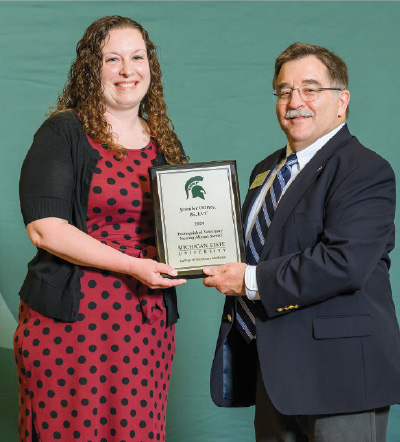

“I joke that I thrive in chaos because I’ve worked here so long that I’m like ‘Yep, that’s shelter life.’ Did the day get twisted? Maybe, but it all turned out alright.” Jennifer Ottney, Surgical Manager at the Capital Area Humane Society (CAHS) in Lansing, Michigan, and a 2004 MSU Veterinary Nursing program graduate, has a contagiously positive attitude.


Originally, Ottney intended to become a veterinarian, but her aunt—a veterinary nurse at the clinic where Ottney worked during her undergraduate education—introduced her to veterinary nursing as an option, and she enjoyed the variety it offered.
Her path to shelter medicine wasn’t direct (she took a detour into zoology), but she has found her passion in shelter work.
The “chaos” that Ottney thrives in is moving approximately twenty animals a day through surgery—whether a routine spay/neuter or something more serious—so they’re ready to be adopted into loving homes.
“It’s similar to emergency medicine; you never know what sort of cases you might see that day,” says Ottney. Luckily, Ottney has a talented team of veterinarians, assistants, and volunteers to work with when she schedules and prepares for surgeries—together they’re able to handle any surprises.
Being a shelter surgery manager entails a laundry list of tasks, and deciding what animals will be slotted in for surgery with which staff members is only a small part. Ottney also assists in surgery, helps maintain surgical equipment and machinery, manages the shelter’s stock of medications and surgical supplies, instructs veterinary nursing students on shelter medicine rotation, and more—all in a shelter’s often bite-sized budget.
“We call it Tetris. Trying to fit everything in is a lot of Tetris-ing,” says Ottney jovially.
The “Tetris” of making everything work in a shelter used to come with a negative connotation, according to Ottney.
“In my experience, people used to think shelters didn’t provide the highest quality of care. We do, but because of limited resources, we go about it differently than your average general practice. But I’ve been working at CAHS for 15 years now, and I’ve seen a positive change in how we’re perceived.”
Ottney believes that education and openness about shelter medicine have helped change minds.
“We are upfront with everything we do. In every medical record, we document when we’re limited by resources or time. Once people got to know us and that we have the best interests of the animal and quality of care in mind, interest in shelter medicine increased.”
CAHS is also a community resource. “We have low-cost vaccine clinics for pets. We are helping animals whether or not they have an owner yet. We have a food bank program to help people access pet food. We are here to help people and help animals,” says Ottney.
Ottney also explains that much has been upgraded since she started working at CAHS, improving the efficiency of what she does.

“We have an X-ray suite in the shelter now! We don’t have to drive animals elsewhere for scans, which saves time and improves their length of stay. Shortening every animal’s length of stay is a big priority for us. I love it, everything is improving,” says Ottney.
There are still some aspects of shelter medicine Ottney wishes more people were informed about.
“There are two different funding structures for shelters; some are government-funded, while non-profits like CAHS are solely donation-based. Everything that we’re able to do for the animals—treating them and getting them onto the adoption floor—is because people are generous. It can feel uncomfortable to say it, but the truth is that money is the biggest hurdle for care, followed by space and staffing.”
The other little-known fact concerns visiting adoptable animals.
“Animals will act differently in a shelter than they will at home! There’s no way around it. Shelters can be overstimulating and stressful places. If you visit a dog in a shelter and the dog is barking at you, remember that you’re in the dog’s space. That dog isn’t mean, it’s just stressed because a stranger is in the only home they have.”
Luckily, Ottney and her colleagues have strategies to help future pet owners get to know animals better.
“We try to send the most stressed ones to foster homes. We are also starting a foster-to-adopt program on a case-by-case basis to let potential owners see if a dog is a good fit for their home. Even if it doesn’t work out and the dog is brought back, at least the dog got a break from the shelter, so we see it as a win-win.”
Much of shelter medicine is finding workarounds for barriers to adoption or treatment. That’s precisely what Ottney loves about the job.
“When I was in the veterinary nursing program, we visited CAHS to do physicals on shelter animals. I was surprised there were so many animals that needed physicals all the time. But most of my interest in shelter medicine came
from living it. I think the work is fascinating and it would take a lot for me to leave.” 